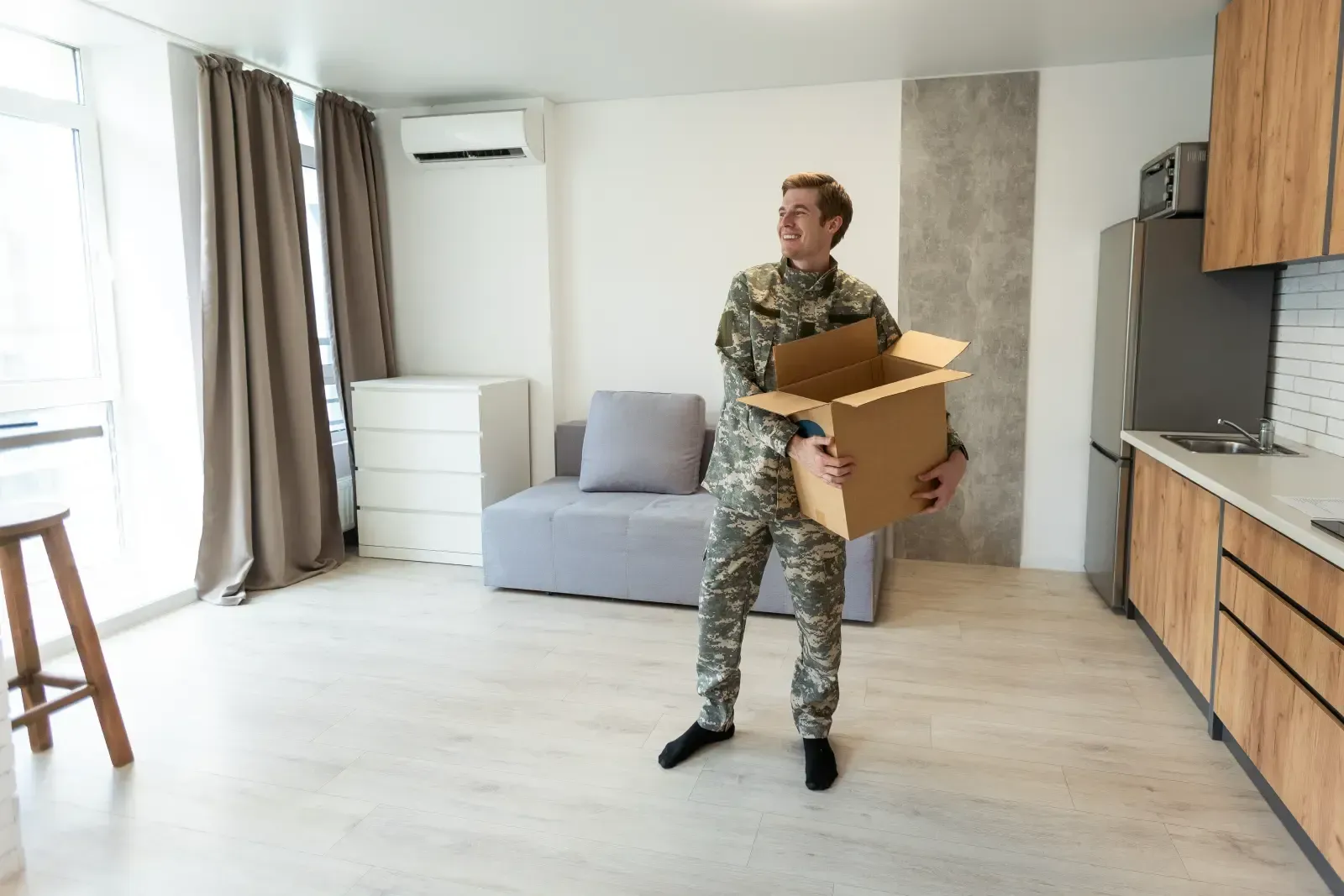Packing for a long-distance move can feel like preparing for an expedition – because in many ways, that's exactly what it is! Your belongings are about to embark on a journey that could span hundreds or even thousands of miles, and proper packing is what stands between your treasured items arriving safely versus becoming casualties of the road.
At Stewart Moving & Storage, we've spent over 20 years perfecting the art and science of long-distance moving. We've seen what works, what doesn't, and what separates a successful move from a stressful one. The difference often comes down to following proven packing tips for long-distance moves.
Whether you're moving across several states or coast-to-coast, these essential packing tips for moving long-distance will help ensure your belongings arrive in the same condition they left – and that you maintain your sanity throughout the process!
Learn more:
- How To Move Heavy Furniture By Yourself: 19 Easy Ways & Tricks
- How to Move a Grandfather Clock Safely in 10 Simple Steps
- How To Pack Plates and Dishes For Moving, Tips Keep Plates Safe
- A Checklist for Virginia Residency Requirements 2025

1. Start Packing Early for a Smooth Long-Distance Move
The number one mistake we see families make is underestimating how long packing actually takes. Here's the truth: packing for a long-distance move takes about three times longer than you think it will, especially if you want to do it right.
Begin 6-8 weeks before your move date with items you won't need in the coming months. Start with:
- Seasonal clothing and decorations
- Books and rarely used electronics
- Artwork and decorative items
- Extra linens and towels
- Kitchen items used only for entertaining
Starting early isn't just about having enough time – it's about having the mental energy to pack carefully. When you're rushing at the last minute, that's when important items get thrown haphazardly into boxes or left behind entirely.
Create a packing timeline and stick to it. Pack one closet or room per week in the early stages, depending on the size of your home, and then accelerate as your move date approaches. This systematic approach prevents the overwhelming feeling of having everything to do at once.
Learn more:
How to Pack Kitchen Items for Moving | Expert Guide
2. Declutter and Organize
Long-distance moves are charged by weight, distance, and time of year, which means every pound counts toward your final cost. Before you start packing, take time to honestly evaluate what's worth moving versus what you should leave behind.
The golden rule for long-distance moves: If it costs more to move an item than to replace it, consider letting it go. This especially applies to:
- Heavy furniture that's seen better days
- Old appliances that may not survive the journey
- Books you'll never read again
- Clothing that doesn't fit or you never wear
- Duplicate kitchen items
Go through each room methodically and sort items into four categories: keep, donate, sell, and trash. Many families discover they can reduce their moving weight by 20-30% through strategic decluttering, leading to significant cost savings.
Host a garage sale, list valuable items online, and donate usable goods to local charities. Starting this process early gives you time to maximize the value of items you're not taking with you.
Learn more:
Moving an Aquarium: How to Pack and Move a Fish Tank
3. Gather Quality Packing Supplies
When your belongings are traveling hundreds of miles and being handled multiple times, quality packing supplies aren't a luxury – they're essential insurance for your items.
Essential packing supplies include:
- Various-sized boxes: Small boxes (1.5 cubic feet) for heavy items like books, medium boxes (3 cubic feet) for general items, large boxes (4.5+ cubic feet) for light, bulky items
- Specialty boxes: Wardrobe boxes for hanging clothes, dish packs for kitchenware, mirror/picture boxes for artwork
- Packing materials: Bubble wrap, packing paper, foam peanuts, and furniture pads
- Tools: Heavy-duty packing tape, tape dispensers, permanent markers, box cutters
- Protection items: Plastic wrap, mattress bags, and furniture blankets
Don't try to save money by using old, worn boxes or insufficient packing materials. The cost of quality supplies is minimal compared to replacing damaged items. At Stewart Moving & Storage, we can provide professional-grade packing supplies or handle the entire packing process for you.
Learn more:
How to Pack a TV for Moving Safely | TV Shipping Guide
4. Pack Heavy Items First
One of the most important packing tips for long-distance moves is understanding proper weight distribution. Heavy items should go in small boxes and be placed at the bottom of your moving truck load.
Heavy items include:
- Books and magazines
- Tools and hardware
- Canned goods and pantry staples
- Small appliances
- Collectibles like coins or pottery
Pack these items in small, sturdy boxes that won't exceed 50 pounds when full. This makes them manageable for movers to handle and reduces the risk of box failure during transport.
Never mix heavy and light items in the same box – it creates an unbalanced load that's difficult to carry and more likely to cause damage. Instead, pack heavy items together in small boxes and light items together in larger boxes.
Learn more:
How to Move a Pool Table | Stewart Moving & Storage
5. Pack Room by Room
Staying organized during a long-distance move requires a systematic approach. Pack one complete room before moving to the next, and keep items from the same room together whenever possible.
Benefits of room-by-room packing:
- Easier to stay organized and track progress
- Similar items are packed together, reducing unpacking time
- You can clean each room thoroughly as you finish packing it
- Less overwhelming than trying to pack the entire house at once
Start with rooms you use least (guest bedrooms, formal dining rooms, basements) and work toward the most essential spaces (kitchen, bathrooms, primary bedroom). This strategy allows you to maintain normal living conditions for as long as possible.
Keep a detailed list of what's packed in each room. This helps with both inventory tracking and unpacking prioritization at your destination.
Learn more:
Cross-Country Moving Tips: Complete Guide
6. Pack Your Carry-On Bags with Essentials
Don’t forget that your long-distance move is like taking a long trip! Just as you wouldn't travel without a carry-on bag, you shouldn't move without easily accessible essentials for each family member.
Pack individual carry-on bags with:
- 3-5 days' worth of clothing and undergarments
- Toiletries and personal care items
- Essential medications
- Important documents (birth certificates, passports, insurance papers)
- Electronics chargers and adapters
- Comfort items for children (favorite toy, blanket, book)
- Cash and credit cards
Keep these bags with you during the move, not loaded on the moving truck. You never know when you might need immediate access to these items, especially if there are delays with your moving truck arrival.
Also, pack a "first day" box for each room with items you'll need immediately upon arrival: toilet paper, basic tools, phone chargers, a coffee maker, and a few dishes.
7. Protect Fragile Items Carefully
Long-distance moves mean more handling, more vibration, and more opportunities for damage. Fragile items require extra attention and protection to survive the journey.
For dishes and glassware:
- Use dish pack boxes with dividers
- Wrap each piece individually in packing paper
- Place heavier items on the bottom, lighter on top
- Fill empty spaces with bubble wrap or packing paper
- Mark boxes clearly as "FRAGILE" on multiple sides
For electronics:
- Use original boxes when possible
- Remove batteries to prevent corrosion
- Wrap in anti-static bubble wrap
- Fill boxes completely to prevent shifting
- Take photos of wire connections before disconnecting
For artwork and mirrors:
- Use picture boxes or custom crates for valuable pieces
- Wrap in bubble wrap and corner protectors
- Mark "THIS SIDE UP" clearly
- Consider professional packing for extremely valuable items
Don't forget about less obvious fragile items like lampshades, plants, and sentimental items that might not have monetary value but are irreplaceable to your family.
Learn more:
- How to Hire An Interstate Moving Company: Steps to Choose a Mover
- How Long Does It Take Movers to Move Cross-Country? Full Timeline
8. Label Everything Clearly
Proper labeling is one of the most crucial packing tips for moving long-distance. When your belongings arrive at your new home, clear labels make the difference between organized unpacking and complete chaos.
Develop a comprehensive labeling system:
- Include destination room and a brief contents description
- Use color-coded tape or stickers for each room
- Number boxes sequentially and keep a master list
- Mark boxes containing essentials with a special symbol
- Indicate which boxes should be unpacked first
Essential labeling strategies:
- "Kitchen – Everyday Dishes" is better than just "Kitchen"
- "Primary Bedroom – Winter Clothes" helps prioritize unpacking
- "FRAGILE – Handle with Care" on multiple sides for breakables
- "THIS SIDE UP" when contents have a preferred orientation
- "OPEN FIRST" for boxes with immediate necessities
Consider creating a simple floor plan of your new home and sharing it with your movers. This helps them place boxes in the right rooms immediately, saving you from moving heavy boxes around later.
Learn more about our services:
- Interstate Moving Services | Cross-State Mover
- Cross-Country Movers | Affordable and Reliable Moving Company
- Military Movers: Local & Long Distance Moving Service For PCS
9. Utilize Space but Don't Overpack
Efficient packing means making the most of available space while ensuring boxes remain safe and manageable. There's a fine line between maximizing space and overpacking, and crossing it can lead to injuries or damaged items.
Space-saving strategies:
- Use soft items (towels, linens, clothing) as padding for fragile items
- Pack small items inside larger ones (socks inside shoes, small kitchen gadgets inside pots)
- Fill hollow spaces in appliances with lightweight items
- Use vacuum-sealed bags for bulky clothing and bedding
- Pack hanging clothes in wardrobe boxes to maintain their shape
Overpacking warning signs:
- Boxes that feel too heavy for two people to lift comfortably
- Bulging sides or bottoms that look stressed
- Difficulty closing box flaps properly
- Items compressed so tightly that they could be damaged
- Boxes that exceed 50 pounds (industry standard weight limit)
Remember, professional movers are trained to handle properly packed boxes efficiently. Overpacked boxes slow down the process and increase the risk of injury and damage.
10. Create an Inventory List
An inventory list is your insurance policy for a long-distance move. It helps track your belongings, assists with damage claims if needed, and makes unpacking much more organized.
Create a comprehensive inventory:
- Number each box and list contents
- Note the condition of valuable items before packing
- Take photos of electronics and valuable items
- Keep serial numbers for electronics and appliances
- Document any existing damage to furniture or items
Inventory organization tips:
- Use a spreadsheet or moving app to stay organized
- Include estimated value for valuation coverage purposes
- Mark high-priority boxes for immediate unpacking
- Keep one copy with you and another in a secure location
- Share a copy with your moving company for their records
This inventory becomes invaluable when you're standing in your new home wondering which box contains sugar for your morning coffee or where you packed your winter coats!
Learn more:
- Average Cost of Cross-Country Movers | Cross-Country Movers Cost
- Interstate Moving Costs 2025: How Much Does It Cost and How to Lower?
BONUS TIP: Hire a Reliable Moving Company
While packing tips for long-distance moves can help you prepare, working with experienced professionals makes all the difference in ensuring your belongings arrive safely and on time.
What to look for in a long-distance moving company:
- Proper licensing and valuation coverage for interstate moves
- Positive reviews and Better Business Bureau accreditation
- Transparent pricing with no hidden fees
- Professional packing services available
- Experience with your specific type of move
- Clear communication throughout the process
At Stewart Moving & Storage, we understand that your belongings represent more than just possessions – they're your memories, your comfort, and your life. Our trained professionals know exactly how to pack, protect, and transport your items across any distance.
Our comprehensive services include:
- Professional packing using high-quality materials
- Secure loading and transportation
- Real-time tracking and communication
- Valuation coverage options
- Flexible delivery timing
- White-glove unpacking services
We've been helping families with long-distance moves for over 20 years, and we've learned that success comes from combining proper preparation with professional execution. Let our family help yours make this transition as smooth as possible.
We provide long distance moving services in many locations:
FAQs About Packing Tips for Moving Long Distances
What is the best way to pack for a long-distance move?
The best approach combines early preparation, quality materials, and systematic organization. Start packing 6-8 weeks early with non-essential items, use high-quality boxes and packing materials, pack room by room, and create detailed inventories. Most importantly, protect fragile items with extra care since they'll be handled multiple times during long-distance transport.
When should I start packing for a long-distance move?
Begin packing 6-8 weeks before your move date, starting with items you won't need immediately like seasonal clothes, books, and decorative items. Create a timeline that gradually increases intensity, leaving only essentials for the final week. This early start reduces stress and allows time for careful, protective packing.
What is the hardest room to pack when moving long distances?
The kitchen is typically the most challenging room due to the variety of items, many fragile pieces, and different shapes and sizes. Kitchens contain everything from delicate glassware to bulky appliances, each requiring different packing strategies. Start with the kitchen early and consider professional packing services for this room to ensure everything arrives safely.
Do movers load furniture or boxes first for long-distance moves?
Professional movers typically load heavy furniture and large appliances first, placing them against the walls of the truck to create a stable foundation. Boxes are then loaded strategically based on weight and fragility, with heavier boxes on the bottom and lighter, fragile items on top. This method maximizes space utilization and minimizes shifting during transport.
How do I not get overwhelmed when packing to move long-distance?
Stay organized with a room-by-room approach, start early to avoid time pressure, and break the task into manageable daily goals. Create checklists, celebrate small victories, and don't hesitate to ask for help from friends or professional packing services. Remember that feeling overwhelmed is normal – focus on progress, not perfection.



